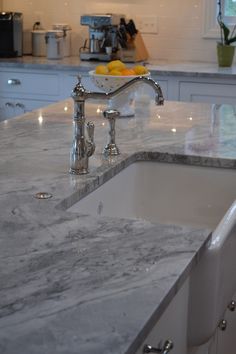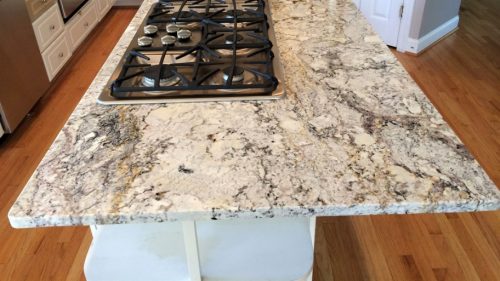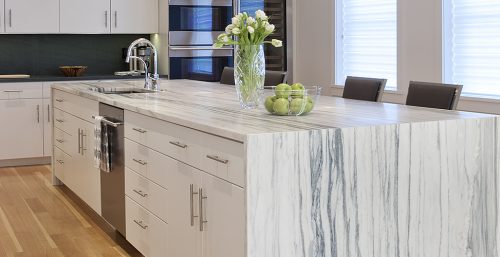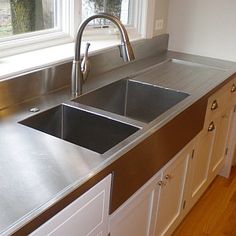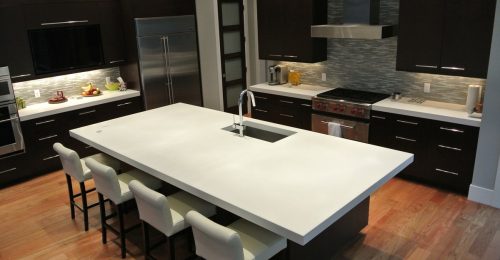Countertop Pros and Cons: What To Choose and Why
Countertop Pros and Cons: What To Choose and Why
Wondering how to choose a countertop for your kitchen? With so much to pick from, it can be challenging – especially with changing trends and so many options that are at similar price points. This pro and con list should help.
Quartz
Quartz is the most popular choice in countertops today because of its easy maintenance and seemingly unending array of looks, from sleek and modern to options that mimic the appearance of exotic stone and classic marble.
Pros: It won’t stain, so go ahead and drink that red wine. Let your kids have at it with the markers and paint. Go crazy and chop those veggies right on the surface since it’s pretty hard to scratch. Quartz also requires no sealing, unlike granite and other countertop materials.
Cons: High-end quartz can be pricier than real stone like granite, and while it’s much easier to care for, it’s not indestructible. Hot pots should still be placed on a trivet to avoid burning the surface.
Granite
While granite has been replaced by quartz as the countertop of choice today, it remains a popular option for homeowners.
Pros: The natural stone comes in a variety of colors and styles, and individual patterns and markings give each slab a unique look. “Granite has a rich beauty that few other countertop materials can match,” said Countertop Guides. “It is a natural product with a timeless aura and appeal.” Granite is also stain- and scratch-resistant, if properly sealed.
Cons: It’s that “properly sealed” part that can make people shy away from granite. Improper maintenance can leave you with a stained, scratched counter. And don’t place a hot pot directly on it or you run the risk of it an ugly burn.
Marble
It’s gorgeous, it’s classic, and it’s showcased all over TV in high-end, remodeled kitchens. But marble has a downside that makes it hard to love for many people: the care involved.
Pros: “Is there anything that looks and feels more glamorous than a marble countertop?,” asks Houzz. “Nothing beats marble for sheer elegance. It stands up to heat well, and because it remains perennially cool, it’s a traditional choice for pastry and baking stations.”
Cons: It’s going to stain, no matter how hard you try to keep it clean, and even if you seal it responsibly. It’s also a softer material, which makes it more likely to scratch and chip.
Stainless Steel
Stainless steel countertops are most commonly found in commercial kitchens but have become more popular as home kitchens have transformed into chef-worthy spaces.
Pros: “Professional chefs love stainless steel because it’s non-staining, heat-resistant and easy to clean,” said Houzz. “While it certainly makes fingerprints and scratches stand out, it’s a great choice for hardworking kitchens that don’t need a perfect look.” It can also be more affordable than stone.
Cons: About those fingerprints…that’s a deterrent for many people. If you can’t stand little marks on your stainless steel fridge, you probably won’t enjoy them on your counters, either. Stainless steel can also look a little cold, and may not be embraced by the masses – something to think about for when it’s time to sell your home.
Concrete
Concrete countertops have gained in popularity over the past few years as industrial looks have become more trendy, and are also a favorite of HGTV personality Joanna Gaines, one of today’s most influential tastemakers.
Pros: Because concrete is poured and not quarried, it can look like almost anything you want, with custom shapes, sizes, and colors. It’s also durable, “and both scratch and heat resistant,” said Angie’s List. “Because each countertop is individually handmade, there are endless ways to customize them.”
Cons: Concrete is porous, shows errors and imperfections, and can easily stain. Some people like that because the changes over time are organic; those who want their countertop looking pristine may want to opt for a product other than concrete. Even with diligent sealing, it’ll never be “perfect.”
Another consideration for people looking to use concrete on their counters is how, or rather, where, it is poured. “Concrete countertops that are poured in place (not precast) may develop a hairline crack,” said Angie’s List. “The cracks aren’t necessarily the result of poor workmanship, rather perhaps a new house settling or tension caused by a faucet screwed in too tightly. Hairline cracks can be tricky to fix – ironically the larger the crack, the easier it is to fill and repair – so you might chalk up any such flaw to being a part of concrete’s natural patina.”
By: Jaymi Naciri
Article found: https://goo.gl/RC0BEH
Filed under: Blog by Steve Henion
No Comments »


